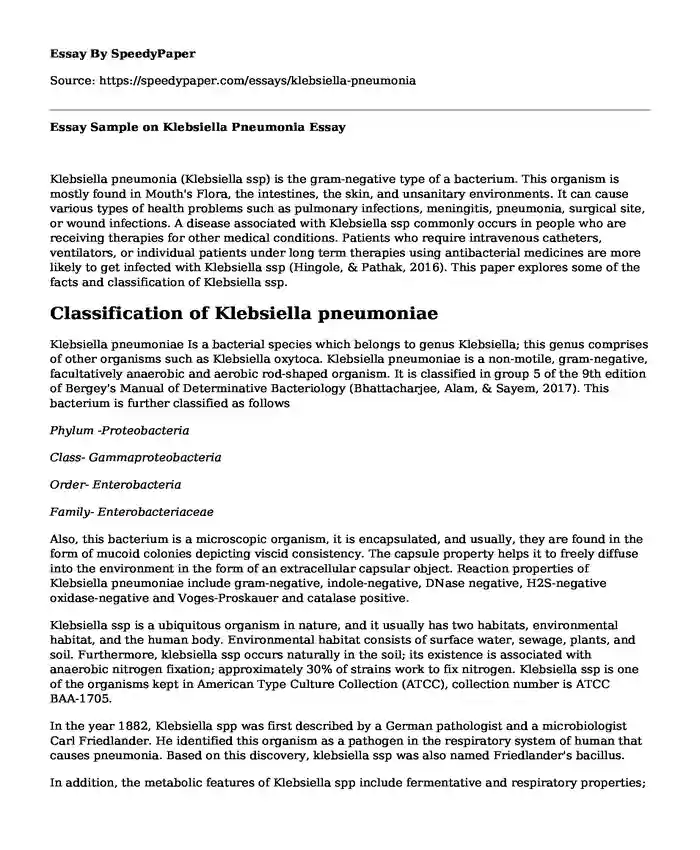
| Type of paper: | Article |
| Categories: | Biology Medicine Healthcare |
| Pages: | 3 |
| Wordcount: | 683 words |
Klebsiella pneumonia (Klebsiella ssp) is the gram-negative type of a bacterium. This organism is mostly found in Mouth's Flora, the intestines, the skin, and unsanitary environments. It can cause various types of health problems such as pulmonary infections, meningitis, pneumonia, surgical site, or wound infections. A disease associated with Klebsiella ssp commonly occurs in people who are receiving therapies for other medical conditions. Patients who require intravenous catheters, ventilators, or individual patients under long term therapies using antibacterial medicines are more likely to get infected with Klebsiella ssp (Hingole, & Pathak, 2016). This paper explores some of the facts and classification of Klebsiella ssp.
Classification of Klebsiella pneumoniae
Klebsiella pneumoniae Is a bacterial species which belongs to genus Klebsiella; this genus comprises of other organisms such as Klebsiella oxytoca. Klebsiella pneumoniae is a non-motile, gram-negative, facultatively anaerobic and aerobic rod-shaped organism. It is classified in group 5 of the 9th edition of Bergey's Manual of Determinative Bacteriology (Bhattacharjee, Alam, & Sayem, 2017). This bacterium is further classified as follows
Phylum -Proteobacteria
Class- Gammaproteobacteria
Order- Enterobacteria
Family- Enterobacteriaceae
Also, this bacterium is a microscopic organism, it is encapsulated, and usually, they are found in the form of mucoid colonies depicting viscid consistency. The capsule property helps it to freely diffuse into the environment in the form of an extracellular capsular object. Reaction properties of Klebsiella pneumoniae include gram-negative, indole-negative, DNase negative, H2S-negative oxidase-negative and Voges-Proskauer and catalase positive.
Klebsiella ssp is a ubiquitous organism in nature, and it usually has two habitats, environmental habitat, and the human body. Environmental habitat consists of surface water, sewage, plants, and soil. Furthermore, klebsiella ssp occurs naturally in the soil; its existence is associated with anaerobic nitrogen fixation; approximately 30% of strains work to fix nitrogen. Klebsiella ssp is one of the organisms kept in American Type Culture Collection (ATCC), collection number is ATCC BAA-1705.
In the year 1882, Klebsiella spp was first described by a German pathologist and a microbiologist Carl Friedlander. He identified this organism as a pathogen in the respiratory system of human that causes pneumonia. Based on this discovery, klebsiella ssp was also named Friedlander's bacillus.
In addition, the metabolic features of Klebsiella spp include fermentative and respiratory properties; usually, this organism ferments all the types of carbohydrates apart from erythritol and dulcitol. Pathogenically, this type of organism is known as an opportunistic pathogen that can lead to health infections such as urinary tract complications, bacteremia, and pneumonia (Seiffert et al. 2019). Usually, it occurs to people whose immune system is weak, also its opportunistic pathogen in case of patients with pulmonary infections and nasal mucosa atrophy. Feces and contact with contaminated objects act as the most considerate source of this organism. One of the major identifying tests for species klebsiella ssp is the susceptibility to derivatives of the three cephalosporins and their differentiation - the test comprised of amino acids decarboxylase, urease, and the production hydrogen sulfide. The process involved fermentation of dextrose and lactose, motility. The results included the isolation of Klebsiella ssp.
Thiry et al. 2019 identify new bacteriophages with respect to emerging lineage ST258 and ST23 of klebsiella ssp using larvae (Galleria mellonella). The objectives of this study were to characterize and isolate the current lytic bacteriophages and identified the possible ways of controlling their infections. The results of this study show that the selected phages can prevent the infection of Klebsiella pneumoniae infection caused by their stains (Thiry et al. 2019).
References
Bhattacharjee, P., Alam, M. Z., & Sayem, S. M. A. (2017). Evaluation of Antibiotic Sensitivity Pattern and Plasmid Isolation of Klebsiella Pneumoniae Isolates from Clinical Specimens in Sylhet City, Bangladesh. Journal of Scientific Research, 9(1), 79-86.
Hingole, S. S., & Pathak, A. P. (2016). Isolation of halotolerant Plant growth promoting Klebsiella pneumoniae from Tuppa, Nanded, Maharashtra. Int. J. Innov. Biol. Res, 5(1), 6.
Seiffert, S. N., Wuthrich, D., Gerth, Y., Egli, A., Kohler, P., & Nolte, O. (2019). First clinical case of KPC-3-producing Klebsiella.
Thiry, D., Passet, V., Danis-Wlodarczyk, K., Lood, C., Wagemans, J., De Sordi, L., ... & Brisse, S. (2019). New Bacteriophages against Emerging Lineages ST23 and ST258 of Klebsiella pneumoniae and Efficacy Assessment in Galleria mellonella Larvae. Viruses, 11(5), 411.
Cite this page
Essay Sample on Klebsiella Pneumonia. (2023, Jan 15). Retrieved from https://speedypaper.com/essays/klebsiella-pneumonia
Request Removal
If you are the original author of this essay and no longer wish to have it published on the SpeedyPaper website, please click below to request its removal:
- Essay Example on Primary Maternal Preoccupation
- Financial Stability and Macro Prudential Policy - Essay Sample on Finance
- Free Essay Example: Nora the Town Girl
- Free Essay Sample: Customer Relationship Management at Amazon
- Free Essay. The Impact of Food on Human Culture and Societies
- Free Essay: Social Responsibility Post-Test
- Free Essay. Enterprise Resource Planning Program
Popular categories




